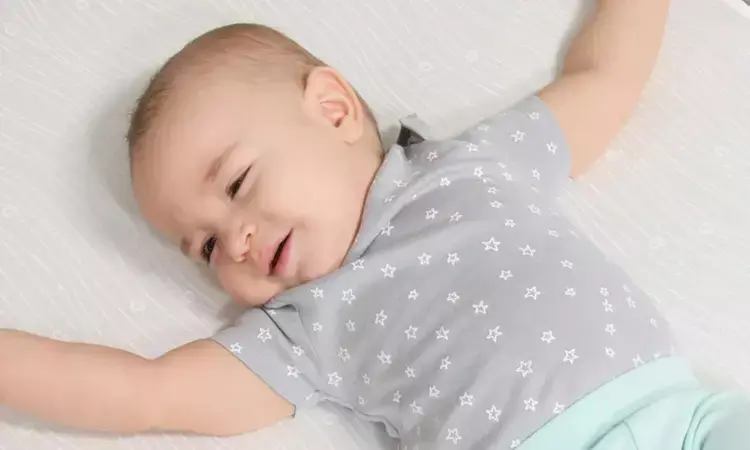- Home
- Medical news & Guidelines
- Anesthesiology
- Cardiology and CTVS
- Critical Care
- Dentistry
- Dermatology
- Diabetes and Endocrinology
- ENT
- Gastroenterology
- Medicine
- Nephrology
- Neurology
- Obstretics-Gynaecology
- Oncology
- Ophthalmology
- Orthopaedics
- Pediatrics-Neonatology
- Psychiatry
- Pulmonology
- Radiology
- Surgery
- Urology
- Laboratory Medicine
- Diet
- Nursing
- Paramedical
- Physiotherapy
- Health news
- Fact Check
- Bone Health Fact Check
- Brain Health Fact Check
- Cancer Related Fact Check
- Child Care Fact Check
- Dental and oral health fact check
- Diabetes and metabolic health fact check
- Diet and Nutrition Fact Check
- Eye and ENT Care Fact Check
- Fitness fact check
- Gut health fact check
- Heart health fact check
- Kidney health fact check
- Medical education fact check
- Men's health fact check
- Respiratory fact check
- Skin and hair care fact check
- Vaccine and Immunization fact check
- Women's health fact check
- AYUSH
- State News
- Andaman and Nicobar Islands
- Andhra Pradesh
- Arunachal Pradesh
- Assam
- Bihar
- Chandigarh
- Chattisgarh
- Dadra and Nagar Haveli
- Daman and Diu
- Delhi
- Goa
- Gujarat
- Haryana
- Himachal Pradesh
- Jammu & Kashmir
- Jharkhand
- Karnataka
- Kerala
- Ladakh
- Lakshadweep
- Madhya Pradesh
- Maharashtra
- Manipur
- Meghalaya
- Mizoram
- Nagaland
- Odisha
- Puducherry
- Punjab
- Rajasthan
- Sikkim
- Tamil Nadu
- Telangana
- Tripura
- Uttar Pradesh
- Uttrakhand
- West Bengal
- Medical Education
- Industry
Vibrating crib mattress effective intervention for newborns with prenatal opioid exposure: JAMA

USA: Stochastic vibrotactile stimulation (SVS) via a crib mattress can serve as a complementary nonpharmacologic intervention for neonates with prenatal opioid exposure (POE), reducing the need for pharmacologic treatment, suggests a recent study published in JAMA Pediatrics.
"Reducing pharmacotherapy with SVS has implications for reduced hospitalization costs and stays, and possible improved infant outcomes given the known negative effect of morphine on neurodevelopment," the researchers reported.
An analysis of 181 newborns with prenatal opioid exposure revealed SVS duration was associated with a significantly decreased risk of pharmacologic treatment. Among infants who completed pharmacotherapy within three weeks, those receiving SVS completed treatment in 3.18 fewer days and received 1.76 mg/kg less morphine compared to infants treated as usual.
Opioids and other pharmacologic agents are often used to treat newborns with prenatal opioid exposure to managing withdrawal and wean from dependence. However, prenatal exposures are known to have neurodevelopmental consequences that may not be addressed by medications prescribed for withdrawal. Neurodevelopmental outcomes may be further exacerbated by opioid medications, such as morphine, used for withdrawal treatment, implying the need for alternative nonpharmacological interventions.
Against the above background, Elisabeth Bloch-Salisbury, University of Pittsburgh School of Medicine, Pittsburgh, Pennsylvania, and colleagues examine the efficacy of a vibrating crib mattress for treating newborns with POE in a randomized clinical trial.
The trial enrolled two hundred eight-term newborns with POE from 2017 to 2020, who were studied at their bedside throughout hospitalization. Half of the cohort received the usual treatment (TAU), and the other half received standard care and low-level SVS using a uniquely constructed crib mattress with a 3-hour on-off cycle within 49 hours of birth. All infants whose symptoms met clinical criteria for pharmacologic treatment received morphine in the neonatal intensive care unit (ICU) per standard care.
The a priori primary outcomes analyzed included pharmacotherapy (morphine administration (AMT), first-line medication at both study sites, and cumulative morphine dose) and hospital length of stay.
One hundred eighty-one newborns completed hospitalization at the study sites (mean gestational age 39.0 weeks; mean birth weight 3076 g, and 55.2% were females).
The authors reported the following findings:
- Of the 181 analyzed infants, 66.9% were discharged without medication, and 33.1% were transferred to the NICU for morphine treatment (51.7% TAU and 48.3% SVS).
- The treatment rate was not significantly different in the two groups: 35.6% of those who received TAU and 30.9% of infants who received SVS).
- Adjusting for the site, sex, birth weight, opioid exposure, and feed type, infant duration on the vibrating mattress in the newborn unit was associated with a reduction in AMT (adjusted odds ratio, 0.88 hours per day). This translated to a 50% relative AMT reduction for infants who received SVS on average 6 hours per day.
- Among 32 infants transferred to the neonatal ICU for morphine treatment who completed treatment within three weeks, those assigned to SVS finished treatment nearly twice as fast (hazard ratio, 1.96), resulting in 3.18 fewer treatment days and receiving a mean of 1.76 mg/kg less morphine than the TAU cohort.
- No effects of the condition were observed among infants treated for more than three weeks.
"The study's findings suggest that SVS may serve as a complementary nonpharmacologic intervention for treating infants with POE; less pharmacotherapy has implications for reduced hospitalization and costs," the researchers conclude.
Reference:
Bloch-Salisbury E, Wilson JD, Rodriguez N, et al. Efficacy of a Vibrating Crib Mattress to Reduce Pharmacologic Treatment in Opioid-Exposed Newborns: A Randomized Clinical Trial. JAMA Pediatr. Published online May 15, 2023. doi:10.1001/jamapediatrics.2023.1077
Dr Kamal Kant Kohli-MBBS, DTCD- a chest specialist with more than 30 years of practice and a flair for writing clinical articles, Dr Kamal Kant Kohli joined Medical Dialogues as a Chief Editor of Medical News. Besides writing articles, as an editor, he proofreads and verifies all the medical content published on Medical Dialogues including those coming from journals, studies,medical conferences,guidelines etc. Email: drkohli@medicaldialogues.in. Contact no. 011-43720751


